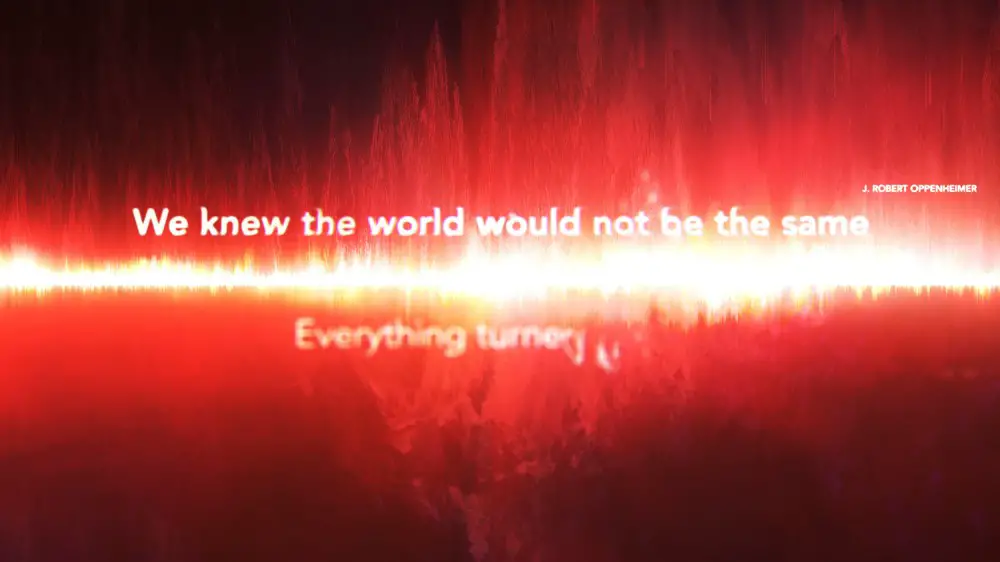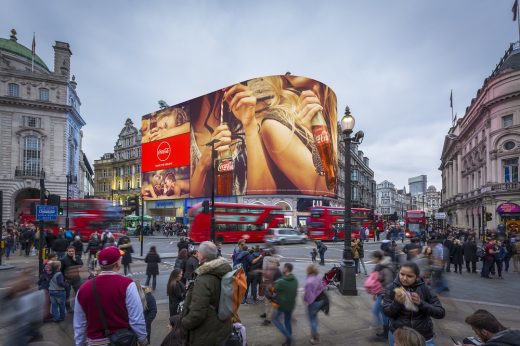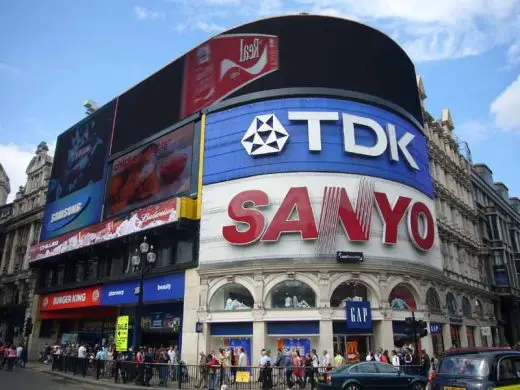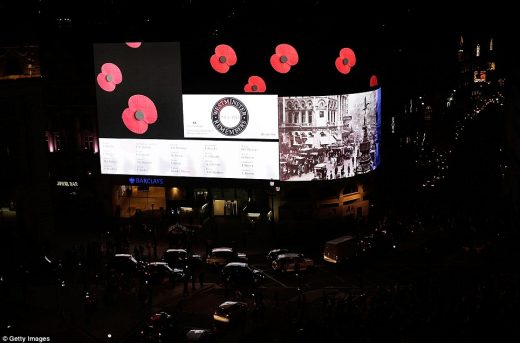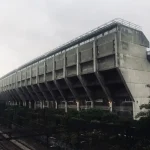Es Devlin, I Saw The World End still, Piccadilly Circus London Japanese Bombings Anniversary
I Saw The World End Exhibition
6 August 2020
New digital artwork commissioned by Imperial War Museums from Es Devlin and Machiko Weston is released to commemorate 75 years since the dropping of the atomic bomb.
image © Es Devlin & Machiko Weston, Still from I Saw the World End, 2020:
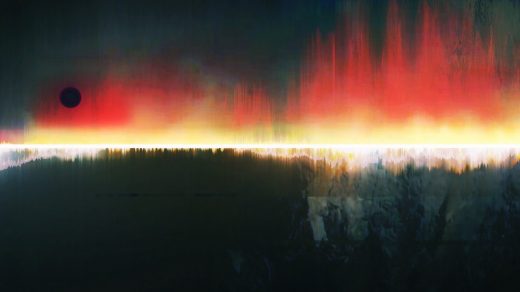
I Saw The World End Exhibition in London
75 years to the day since the dropping of the atomic bomb on the Japanese city of Hiroshima by allied forces during the Second World War, a new digital artwork from contemporary artist Es Devlin, working in collaboration with her long-term studio colleague Machiko Weston, was released this morning.
The artwork has been specially commissioned by Imperial War Museums (IWM) to mark the 75th anniversary of the dropping of the atomic bombs on Hiroshima and Nagasaki and the final days of the Second World War.
image © Es Devlin & Machiko Weston, Still from I Saw the World End, 2020:
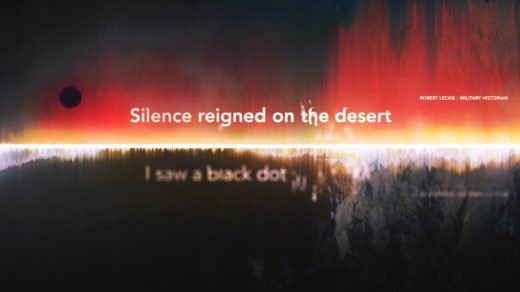
I Saw The World End responds to the moment the nature and consequences of war changed forever. The artwork takes the form of an illuminated ‘collective reading’, the text for which has been collated by Devlin and Weston from a range of sources in Japanese and English, exploring both perspectives on the dropping of the atomic bombs on Hiroshima and Nagasaki. These momentous events in August 1945 contributed to bringing the Second World War, the most devastating conflict in modern global history, to a close.
image © Es Devlin & Machiko Weston, Still from I Saw the World End, 2020:
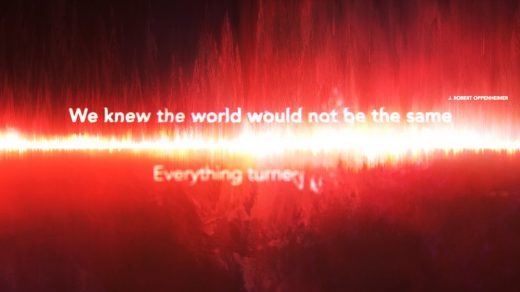
The artwork has been released on IWM’s website and social media channels today and forms part of IWM’s extensive digital programme to mark the 75th anniversary of the end of the Second World War, a programme which also includes Voices of War – audio compilations from IWM’s rich sound archive. These, together with associated videos and blogs, invite audiences to question what the end of the Second World War meant to people around the world.
image © Es Devlin & Machiko Weston, Still from I Saw the World End, 2020:
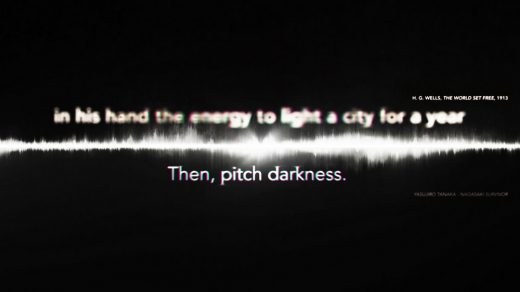
Susie Thornberry, Assistant Director Public Engagement and Learning at IWM, said:
“IWM’s programme to mark 75 years since the end of the Second World War explores not only how the conflict came to an end but the new world that was born out of it. 75 years ago, atomic weapons were used for the first and only time in war. Es and Machiko’s artwork, from the perspective of a British and a Japanese artist, creates a powerful impression of the devastation caused by these weapons, the threads which led to their existence, and their lasting cultural and social impact.”
Artists Es Devlin and Machiko Weston said:
“We have been sharing a studio for over 12 years, often exploring fictional apocalypses in drama and opera, but this is the first time we have jointly explored the impact of the Hiroshima and Nagasaki bombings on our respective cultures. Locked down in separate studios during the pandemic, we researched and collated the text from a range of sources in English and Japanese. Half of the text is in English and traces the origination of the atomic bomb in fiction by HG Wells, the account of the translation directly from fiction to physics by Leo Szilard, and the aspiration, rationale and rehearsal by the leading protagonists of the Manhattan project.
image © Es Devlin & Machiko Weston, Still from I Saw the World End, 2020:
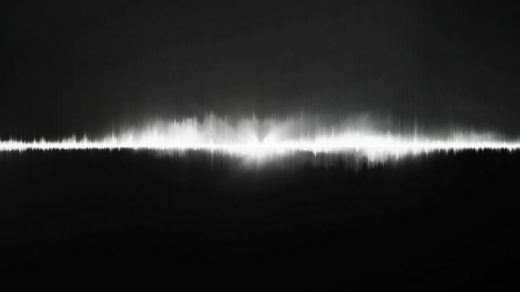
The other half is in Japanese – with simultaneous translation into English – which are all accounts of the two moments in time when the atomic bombs landed on Hiroshima and Nagasaki. The screens have been divided and is the essence of the work, expressing the potential for division – splitting the screen, splitting the atom, the division between fiction and fact, race divisions, the division between humans and the planet.”
On 6 August 1945, Allied forces dropped an atomic bomb on the Japanese city of Hiroshima. Three days later, a second atomic bomb was dropped on the city of Nagasaki. The two bombings killed over 100,000 people directly, most of whom were civilians, and caused thousands more to die of their injuries or the after-effects of radiation. The detonation of these weapons remains the first and only time they have been used in war.
To mark the end of the Second World War, IWM is also sharing first-hand testimonies of the intense combination of celebration, trepidation and devastation felt during August 1945 from its rich sound archive. Three new instalments of Voices of War, whose VE Day soundscape reached tens of thousands of people in May, are being released on IWM’s website and social media channels in August to mark the dropping of the atomic bombs on Hiroshima and Nagasaki and the official end of the Second World War on 15 August, which was recognised as VJ Day by the allied nations.
3 August 2020
‘I Saw The World End still’ London by Es Devlin & Machiko Weston
British And Japanese Artists Es Devlin And Machiko Weston Collaborate on
New Commission To Commemorate The 75th Anniversary Of The Bombings Of Hiroshima And Nagasaki
Es Devlin, I Saw The World End still:
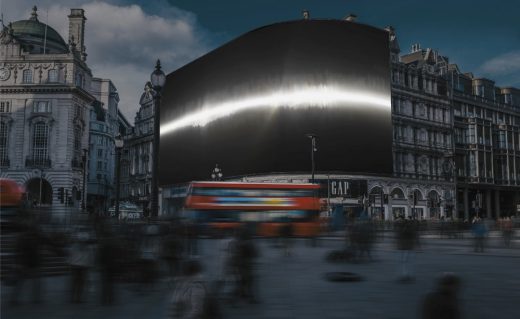
To mark the 75th anniversary of the bombings of Hiroshima and Nagasaki on 6th and 9th August 2020, (IWM) Imperial War Museums have commissioned a new work from leading artist Es Devlin working in collaboration with her long-term studio colleague Machiko Weston.
Closely aligning with the timings of the actual bombings, the 45-metre-wide digital work will be shown on the Piccadilly Lights giant screen in Piccadilly Circus at 8.10am on Thursday 6th and at 11am on Sunday 9th August and simultaneously on the Imperial War Museum website.
The new commission, I Saw The World End, responds to the moment the nature and consequences of war were irrevocably redefined, reflecting on the impact of the event from both a British and a Japanese perspective.
Locked down in their separate studios, the text has been researched and collated by the two artists from a range of sources in English and Japanese. Half of the text, read by Devlin in English, traces the origination of the atomic bomb in fiction by HG Wells, the account of the translation directly from fiction to physics by Leo Szilard, and the aspiration, rationale and rehearsal by the leading protagonists of the Manhattan project. The other half of the text is read in Japanese by Weston – with simultaneous translation into English – which are all accounts of the two moments in time when the atomic bombs landed on Hiroshima and Nagasaki.
A stipulation from Piccadilly Lights to divide the screen (in keeping with its original multi-screen composition) inspired a central aspect of the work’s final form. The screen-splitting line becomes the essence of the work, expressing the potential for division – splitting the screen, splitting the atom, the division between fiction and fact, race divisions, the division between humans and the planet.
The soundtrack, by composers and sound designers Polyphonia, has been created using binaural acoustic techniques – allowing a further expression of division – as the two voices appear to be spatially divided between right and left ears of headphones through which viewers will listen while watching the big screen.
The United States detonated two nuclear weapons over the Japanese cities of Hiroshima and Nagasaki on 6 and 9 August 1945, respectively, with the consent of the United Kingdom, as required by the Quebec Agreement. The two bombings killed over 100,000 people directly, most of whom were civilians, and caused thousands more to die of their injuries or the after-effects of radiation. The detonation of these weapons remains the first and only time they have been used in war.
I Saw The World End
08.10 am on 6th August 2020
11.00 am on 9th August 2020
Piccadilly Lights, Piccadilly Circus, London W1B 5RA
https://www.iwm.org.uk
An older photo of the Piccadilly Circus billboard building on the north side of the public space:
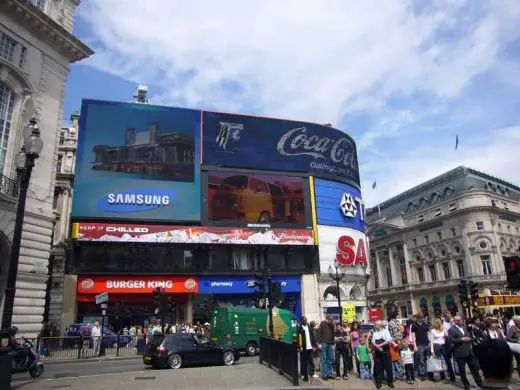
photograph © Adrian Welch
Es Devlin
Es Devlin is known for creating large-scale sculptures and performance spaces that combine light, music and language including Memory Palace in 2019 which mapped shifts in human perspective over 73 millennia, and the reflective labyrinthine self-portrait MirrorMaze in 2016. Her work in collective, AI-generated poetry has been seen at the Serpentine Gallery, V&A and Barbican and is now informing her design for the UK Pavilion for the World Expo 2021.
She collaborated with theoretical physicist Carlo Rovelli on a collective reading of his illuminating work on the nature of time and has conceived stage sculptures with Beyoncé, Billie Eilish, The Weeknd and U2 as well as Olympic Ceremonies and two decades of opera, drama and dance worldwide. Her practice was the subject of the Netflix documentary series Abstract: The Art of Design, and she has been named artistic director of the 2020 London Design Biennale. Devlin has been awarded the London Design Medal, three Olivier awards, a University of Kent doctorate and a UAL fellowship. She has been named RSA Royal Designer for Industry and was made OBE in 2015.
Machiko Weston
Machiko Weston is an Associate Designer at Es Devlin Studio, having trained in Architecture at the Nagoya Institute of Technology and Set Design for Stage and Screen at the Wimbledon School of Art. She has worked on multiple exhibitions and stage projects around the world including Die Tote Stadt at the Finnish National Opera and Tokyo’s New National Theatre, The Lehman Trilogy at the National Theatre and New York’s Park Avenue Armory, High Tide for Carmen at the Victoria & Albert Museum, and concerts tours such as Adele Live 2016. Core interests in her personal art practice include visual storytelling, perspective in scaled model-making, and the relationship between Japanese and British culture.
IWM
IWM (Imperial War Museums) tells the story of people who have lived, fought and died in conflicts involving Britain and the Commonwealth since the First World War.
Our unique collections, made up of the everyday and the exceptional, reveal stories of people, places, ideas and events. Using these, we tell vivid personal stories and create powerful physical experiences across our five museums that reflect the realities of war as both a destructive and creative force. We challenge people to look at conflict from different perspectives, enriching their understanding of the causes, course and consequences of war and its impact on people’s lives.
IWM’s five branches which attract over 2.5 million visitors each year are IWM London, IWM’s flagship branch that recently transformed with new, permanent and free First World War Galleries alongside new displays across the iconic Atrium to mark the Centenary of the First World War; IWM North, housed in an iconic award-winning building designed by Daniel Libeskind; IWM Duxford, a world renowned aviation museum and Britain’s best preserved wartime airfield; Churchill War Rooms, housed in Churchill’s secret headquarters below Whitehall; and the Second World War cruiser HMS Belfast.
24 Jan 2017
Piccadilly Lights Renewal
The iconic Piccadilly Lights owned by Land Securities had a major upgrade from January 2017.
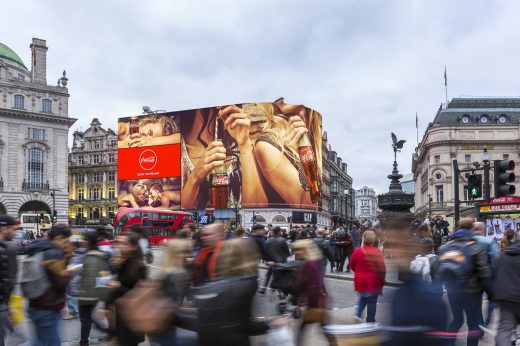
image courtesy Land Securities
Piccadilly Circus Photos
Piccadilly Circus used to be surrounded by illuminated advertising hoardings, starting in 1908 with a Perrier sign.
Piccadilly Lights London from the past:
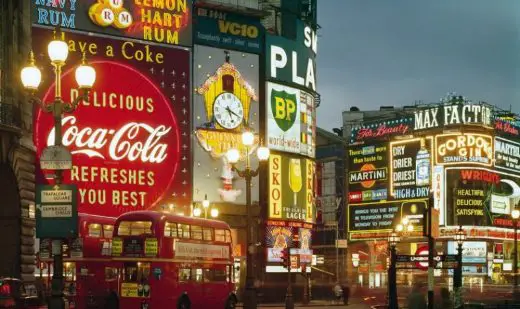
e-architect editor Adrian Welch got a rare opportunity to view the famous advertising elements from behind and from the top:
Location: Piccadilly Circus, London, England, UK
London Building Designs
Contemporary London Architecture Designs
London Architecture Designs – chronological list
London Architecture Walking Tours – tailored UK capital city walks by e-architect
Piccadilly Circus Building Development Proposal
Design: Fletcher Priest, architects
Piccadilly Circus London Building
Richard Deacon’s Cornice
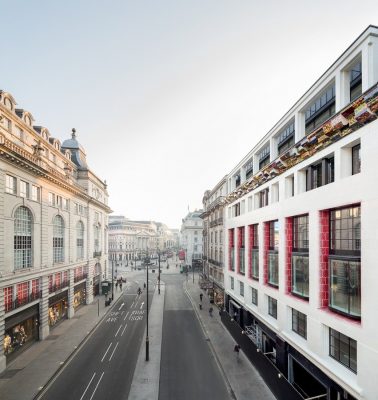
photograph : Dirk Lindner
Piccadilly Building Art
Piccadilly Building
Design: Squire and Partners
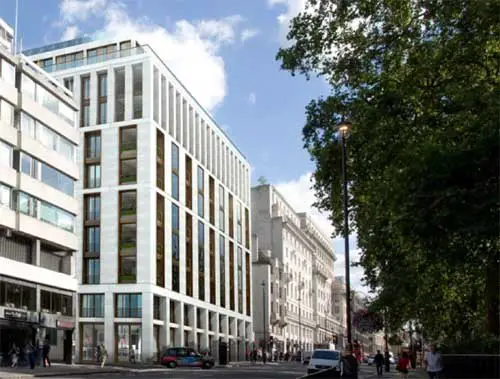
image from architect
Piccadilly Building
Key Public Spaces close by
London Architecture – Selection
Buildings / photos for the Es Devlin, I Saw The World End still at Piccadilly Circus page welcome
Website: Piccadilly Circus

